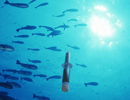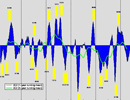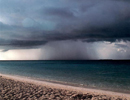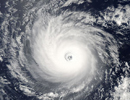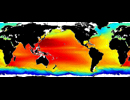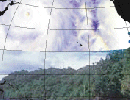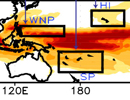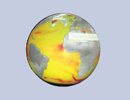HYCOM + NCODA Global 1/12° Reanalysis (GLBu0.08 Experiment 19.0 & 19.1)
The HYCOM Consortium provides a uniformly gridded reanalysis product based on Hybrid Coordinate ocean Model (HYCOM) and the Navy Coupled Ocean Data Assimilation (NCODA).
The system is configured for the global ocean with HYCOM 2.2 as the dynamical model. Computations are carried out on the GLBb0.08 computational grid but here the output served on the uniform GLBu0.08 grid. There are 32 vertical layers (see blkdat.input). The bathymetry is derived from the 30-arc second GEBCO dataset. Surface forcing is from 1-hourly National Centers for Environmental Prediction (NCEP) Climate Forecast System Reanalysis (CFSR) with horizontal resolution of 0.3125° and includes wind stress, wind speed, heat flux (using bulk formula), and precipitation. The diurnal cycle is adequately resolved because of the temporal frequency of the input forcing. For additional details on the model configuration such as layer reference densities time steps, advection scheme, mixing etc. see blkdat.input. Except for the input forcing, the configuration of this Ocean Reanalysis is the same as the Global Ocean Forecast System 3.0, i.e. GLBa0.08-90.X and 91.X also served at HYCOM.
Experiments:
19.1 (Aug 1, 1995 to Dec 31, 2012)
19.0 (Oct 2, 1992 to Jul 31, 1995) Note that the experiment number changes from 19.0 to 19.1 in August 1995 because the integration of the hindcast was moved from the Navy DoD Supercomputing Resource Center (DSRC) IBM Power 6 (DaVinci) to the IDataPlex (Kilrain) supercomputer. There were small changes to NCODA, but none that should have any significant impact on the model solution.
Data Assimilation
The system uses the Navy Coupled Ocean Data Assimilation (NCODA) system (Cummings, 2005, Cummings and Smedstad, 2013) for data assimilation. NCODA uses the model forecast as a first guess in a 3D variational scheme and assimilates available satellite altimeter observations (along track obtained via the Naval Oceanographic Office (NAVOCEANO) Altimeter Data Fusion Center) satellite and in-situ Sea Surface Temperature (SST) as well as available in-situ vertical temperature and salinity profiles from XBTs, Argo floats and moored buoys. MODAS synthetics are used for downward projection of surface information (Fox et al., 2002). Note: Thia dataset is enormous. Please download small enough volumes at a time.Disclaimer:
This is a demonstration product from the HYCOM Consortium and is provided as is. HYCOM Consortium does not warrant or suggest that this data is fit for any particular purpose. Further, neither COAPS nor HYCOM consortium guarantee availability, service updates or timely data delivery.References
- NRL Website
Contains snapshots, animations forecast verification statistics and model data comparisons. - (Cummings and Smedstad, 2013)
J. A. Cummings and O. M. Smedstad. 2013: Variational Data Assimilation for the Global Ocean. Data Assimilation for Atmospheric, Oceanic and Hydrologic Applications vol II, chapter 13, 303-343. - (Cummings, 2005)
Cummings, J.A., 2005: Operational multivariate ocean data assimilation. Quart. J. Royal Met. Soc., Part C, 131(613), 3583-3604. - (Fox et al., 2002)
Fox, D.N., W.J.Teague, C.N. Barron, M.R. Carnes, and C.M. Lee, 2002. The Modular Ocean Data Assimilation System (MODAS). J. Atmos. Ocean. Technol., 19, 240-252.
| Variables |
SSH (m), eastward velocity (m/s), northward velocity (m/s), temperature (not potential temperature) (degC), and salinity (psu).
|
| Zonal | Global by varies |
| Meridional | 80.48S to 80.48N by a uniform 0.08 |
| Vertical | 0, 2, 4, 6, 8, 10, 12, 15, 20, 25, 30, 35, 40, 45, 50, 60, 70, 80, 90, 100, 125, 150, 200, 250, 300, 350, 400, 500, 600, 700, 800, 900, 1000, 1250, 1500, 2000, 2500, 3000, 4000, 5000 m |
| Temporal | Oct 2, 1992 to Dec 31, 2012: daily snapshot at 0Z or 3 hourly Missing dates |
| Static? | yes |
| Volume | 8.3 Tb/year |
| Server | public:      |
| Source | HYCOM Consortium |
| Acquired | Dec 3, 2017 |
| APDRC contact | |
| Supplements | https://hycom.org/data/glbu0pt08/expt-19pt0 |

